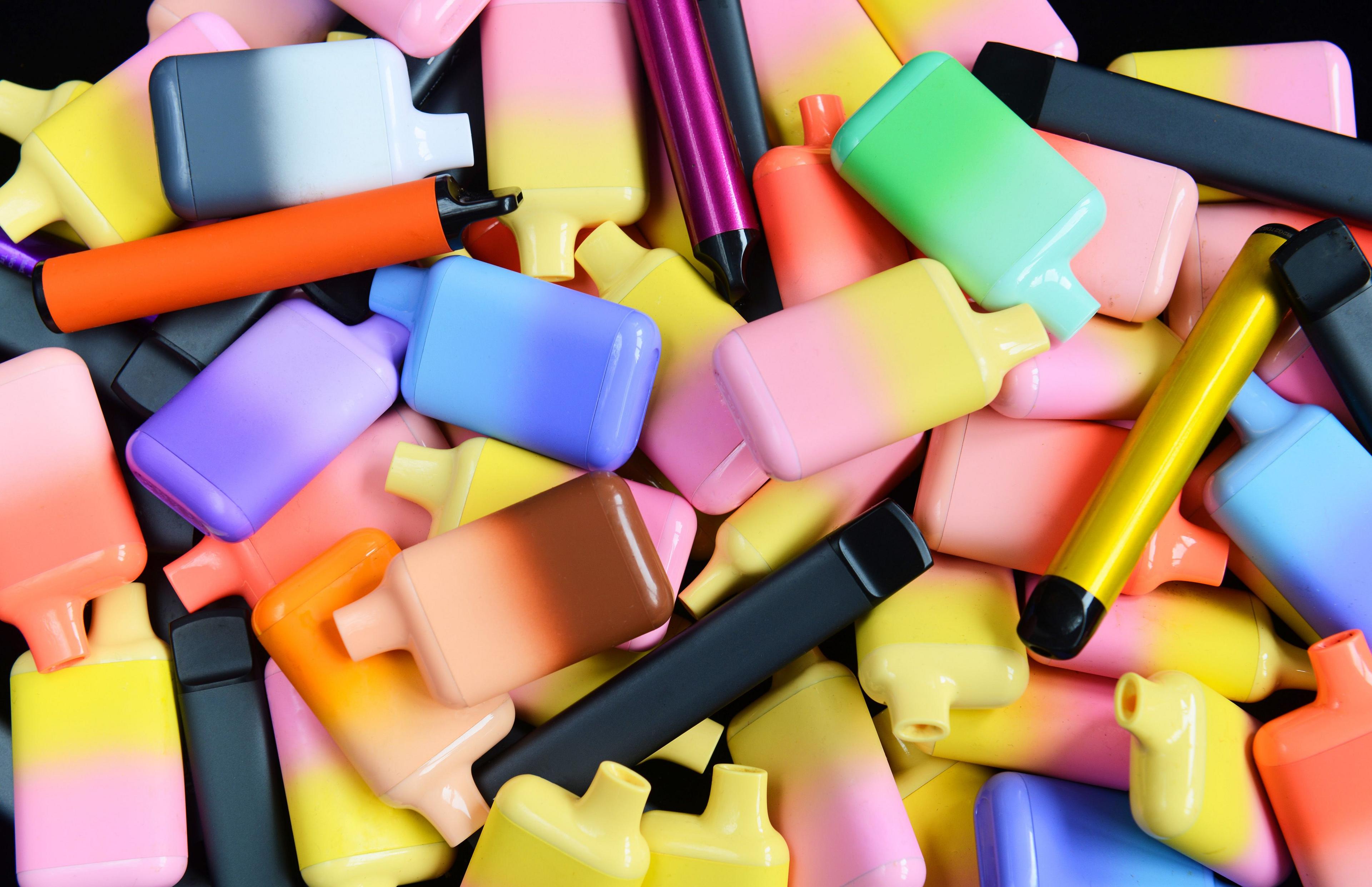How does the disposable vape ban work, and how harmful is vaping?

Disposable vapes have been found to damage the environment
- Published
It has been illegal for businesses to sell or supply disposable vapes in the UK since June.
The government said the ban would reduce environmental damage and help cut the number of children and young people vaping.
How does the disposable vape ban work?
The ban on disposable vapes applies to both shops and online retailers.
Those caught breaking the law in England face a minimum £200 fine, with a prison sentence of up to two years for repeat offences. Penalties are broadly similar in Scotland, Wales and Northern Ireland.
Trading Standards can seize any single-use vapes being sold.
Only reusable devices can be legally sold. They must have a rechargeable battery, a replaceable coil, and be refillable.
Vapes should be returned to stores or recycling centres for specialist handling.

However, waste firm Biffa told the BBC it had seen an increase in the number of vapes incorrectly mixed in with general recycling since the ban. It said this has caused an increase in fires.
Vapes contain lithium-ion batteries, which can catch fire when crushed in bin lorries or at recycling centres. Biffa said it dealt with 60 fires caused by vapes and other small electrical items in June alone.
Another of the UK's largest waste firms, Veolia, said vapes and other battery-operated items cause a fire every day in its lorries and facilities.

A suspected vape fire at a recycling facility in Aldridge, Staffordshire in January
Why are disposable vapes bad for the environment?
Almost five million single-use vapes were thrown away each week in 2023, according to the Department for Environment, Food, and Rural Affairs (Defra).
Vapes contain circuit boards which can leak toxic compounds such as cobalt and copper if they are not disposed off correctly, posing a risk to fish and marine mammals.
These minerals and the lithium could - if properly recovered - be reused for green technologies such as electric car batteries or in wind turbines.
However, recycling vapes is not straightforward because of their size and the way they are manufactured, making them difficult to take apart.
Disposable vape ban begins - but will it have an impact?
- Published1 June
Millions of vapes seized in illegal trade crackdown
- Published24 April
I ordered drug-laced vapes on Snapchat. It was as easy as picking up pizza
- Published6 September
How else are vaping rules changing?
Vaping tax
Vaping products are already subject to 20% VAT but, unlike tobacco, they do not attract a separate additional tax.
However, a new vaping duty will start on 1 October 2026. It will be charged at a flat rate of £2.20 per 10ml vaping liquid.
At the same time, tobacco duty will be increased to preserve the financial incentive for cigarette smokers to switch to vaping.
Advertising and sponsorship ban
The government's Tobacco and Vapes Bill - which is currently making its way through Parliament, external - will outlaw vape advertising and sponsorship.
It will also restrict the flavours, packaging and display of vapes and other nicotine products.
The British Medical Association (BMA) argued that vapes' bright colours and flavours such as bubble gum or candy floss made them attractive to children.
Illegal vapes
The government is also cracking down on iIlegal vapes, which are widely available and are much more likely to contain other harmful chemicals or drugs.
More than six million illegal vaping products were seized by Trading Standards officers across England between 2022 and 2024, according to analysis by the BBC.
How many children and adults vape?
Although it is illegal to sell or supply vapes to under-18s, the number of children vaping has increased sharply in recent years.
Around 20% of 11 to 17-year-olds (1.1 million) in Great Britain have tried vaping, external, according to a 2025 survey by health charity ASH (Action on Smoking and Health).
About 7% (400,000 children) said they currently vaped, with 3% (160,000) saying they vaped daily. Older children were more likely to vape.
ASH found 2.8% of 11 to 17-year-olds said they smoked cigarettes and vaped.

The NHS says vaping should only be for adults quitting smoking
According to the ASH survey, 10% of over-18s in Great Britain said they vaped, external, an estimated 5.5 million people. This was down slightly from 2024, suggesting vape use may be levelling off.
Some 13% adults said they smoked, which has been at the same level since 2021.
The survey found that 55% of current vapers were ex-smokers, while 40% still smoked.
Sharp rise in vaping among young adult non-smokers
- Published3 October 2024
How harmful are vapes to children and adults?
Vaping is nowhere near as harmful as smoking cigarettes, which contain tobacco, tar and a range of other toxic cancer-causing chemicals, and is one of the largest preventable causes of illness and death in the UK.
But because vaping may itself cause long-term damage to lungs, hearts and brains, it is only recommended for adult smokers trying to quit as part of the NHS "swap to stop" programme.
The vapour inhaled contains a small amount of chemicals, often including the addictive substance nicotine, which poses a greater risk to young people than to adults, external.
"Vapes can be an effective way for adult smokers to quit - but we have always been clear that children and adult non-smokers should never vape," the Department of Health and Social Care (DHSC) has said.
More research is needed to fully understand the effects of vaping, but in December 2023, the World Health Organization (WHO) warned "alarming evidence" was growing about the damage it causes.
In February 2025, the government said a £62m research project would track 100,000 eight to 18-year-olds for a decade to better understand the risks.
Related topics
- Published5 September


